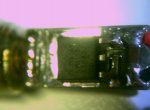- Joined
- Aug 28, 2009
- Messages
- 37
- Points
- 0
I made an lpc laser with a homemade driver built with an lm1117 (since it has a lower voltage drop than an lm317), but i'm having an issue
My multimeter says that it's running at 385 mA, the highest i can get it to go to, but, with each passing second, it drops down one mA. I've only run it long enough for it to drop down to 375, but it's still kinda weird. This is the second diode i'm using in this build, since i had a similar thing with the first. I could only turn the current up to 380 with my first diode, so i turned the trimmer (potentiometer) a ton, instead of in one turn increments like i was doing before, kinda in irritation, thinking that it wouldn't go further, but when i turned it back on, it was at over 600mA and the diode died after a split second. With this diode, i couldn't get it over 385, which makes no sense to me, and I noticed the gradual decrease in current. The thing is, the laser still looks fine, although this is my first lpc build. it's extremely bright, and the beam is visible, especially at night.
It's running off of 3 AA alkaline batteries, since the voltage drop of the lm1117 is, like, 1.2v. The circuit is an lm1117, a 20ohm trimmer, a 47microfarad capacitor, and a 1ohm resister to measure current. Basically a DDL driver with an lm1117.
I don't want to mess with it anymore for fear of losing another diode
Does anyone have any idea what's causing the gradual decrease in current or why i can't get my potentiometer to go above 380 unless i crank it up a ton? Is it some sort of faulty electircal component?
My multimeter says that it's running at 385 mA, the highest i can get it to go to, but, with each passing second, it drops down one mA. I've only run it long enough for it to drop down to 375, but it's still kinda weird. This is the second diode i'm using in this build, since i had a similar thing with the first. I could only turn the current up to 380 with my first diode, so i turned the trimmer (potentiometer) a ton, instead of in one turn increments like i was doing before, kinda in irritation, thinking that it wouldn't go further, but when i turned it back on, it was at over 600mA and the diode died after a split second. With this diode, i couldn't get it over 385, which makes no sense to me, and I noticed the gradual decrease in current. The thing is, the laser still looks fine, although this is my first lpc build. it's extremely bright, and the beam is visible, especially at night.
It's running off of 3 AA alkaline batteries, since the voltage drop of the lm1117 is, like, 1.2v. The circuit is an lm1117, a 20ohm trimmer, a 47microfarad capacitor, and a 1ohm resister to measure current. Basically a DDL driver with an lm1117.
I don't want to mess with it anymore for fear of losing another diode
Does anyone have any idea what's causing the gradual decrease in current or why i can't get my potentiometer to go above 380 unless i crank it up a ton? Is it some sort of faulty electircal component?






